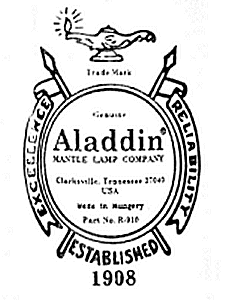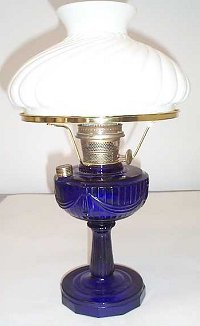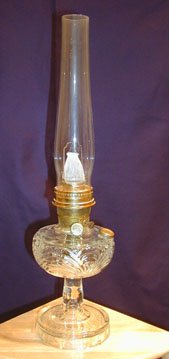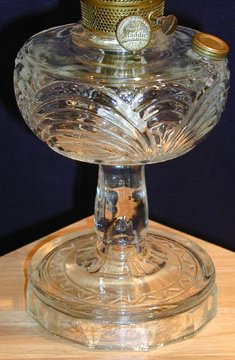



A number of years ago, my wife inherited most of a kerosene lamp from her great-aunt. It sat on a top shelf for years, more or less neglected, until I looked up at it one day and, in a spasm of annoyance at having something else that didn’t work, decided to see if I couldn’t find the missing bits and make a working lamp of it. And that, dear reader, was how I got to fiddling with Aladdin lamps and found yet another old technology to appreciate. (Despite working as a computer support tech and sysadmin, I have an atavistic fondness for old technologies and machines.) As it turned out, this particular technology is one that’s still very much alive, although not all that high-profile until recently. During the Great Y2K Scare, Aladdin had orders for far more lamps than they could possibly produce, resulting in delivery backlogs up to six months. Since the passage of the new year without The End Of The World As We Know It (and R.E.M. feels fine), and after the company was sold to a group of Aladdin collectors and enthusiasts with good business sense, availability has returned to something closer to normal.
The Aladdin lamp was the product of The Mantle Lamp Company, first made in 1908 and in production ever since. It represented the melding of two advances in nineteenth-century lighting: the Argand round-wick burner and the Welsbach gas mantle. The Argand burner has a cylindrical central tube with a pierced cap around which a circular wick rises; the tube allows more air to mix with the fuel. However, the burner by itself still produces a flame that is only marginally brighter than ordinary flat-wick lamps, and also creates smoke and an unpleasant smell, and the design also resulted in greater fuel consumption than in flat-wicked lamps. Even so, many lamps of the late 19th century used the round-wick burner because it did produce a somewhat better light.
The genius of the Aladdin lamp lay in combining an improved version of the Argand burner with the Welsbach gas mantle. Austrian Baron Carl von Welsbach discovered in 1885 that placing a conical mantle woven from strands several rare minerals over an ordinary gas flame made the rare earths in the mantle glow with a brilliant, near-white light, far more illumination than could be achieved even by electric lights which, in any event, were just coming to be available. Even this improvement was not originally American; Victor S. Johnson, the founder of The Mantle Lamp Company, was drawn in by seeing a German-made mantle lamp in 1905. He realized that this was a technology that could fill a huge need in the United States: a lamp that produced a bright, reliable light, and that could be used in rural areas where there was no electricity. Johnson began as a distributor for the first lamp he saw, the “Practicus,” but after a short time he decided to go into manufacturing lamps himself, and incorporated The Mantle Lamp Company in 1908, headquartered in Chicago.
Aladdin lamps were a quantum leap ahead in lighting, so revolutionary that customers willingly paid a premium price of $4.50 for them, in a day when an ordinary lamp could be bought for a quarter. Aladdin salesmen often worked on the approval system, calling in at houses where they saw the yellow flicker of a flat-wick kerosene lamp through a window, and leaving an Aladdin lamp, saying that they would call back through in a week and if the householder liked the lamp, he could buy it; if not, the salesman would pick it up and go on. There were remarkably few lamps returned, for they sold themselves. Properly adjusted, an Aladdin lamp could (and can) put out a light equal to that of a sixty-watt bulb, at an economical fuel consumption (about one quart of kerosene per twelve hours).
The first fifteen years or so the Aladdin was produced it had a metal font, and used a burner with a draft tube that ran centrally through the font and burner, known, naturally, as the “center draft” burner. Lamps were identified by their model numbers (1 through 12), each model being produced for only two or three years. However, beginning in the mid-1920s, Aladdin introduced two great improvements, one mechanical and one aesthetic. The mechanical improvement was a re-design of the burner so air was drawn through a pierced grill in the side of the burner, obviating the need for the central draft tube. This freed the company to experiment with a greater variety of font and pedestal design, and experiment they did. They began releasing what became a wide range of pressed-glass font designs and colors, a practice that continues to the present. Glass font lamps are referred to by their font design names and colors. A number of today’s more expensive and collectible lamps were made in various shades of a translucent glass known as “moonstone;” others were produced in a white glass known as alacite, which was developed by Aladdin and is peculiar only to their lamps.
The issue of color variation in glass Aladdin lamps is a vexing one. As one might expect, color varied from one batch of glass to another and lamps which are called, for example, “amber” may range from orange to brown. Likewise, “green” can mean anything from spring leaves to bluish emerald. This makes collecting colored glass lamps interesting, since you as a collector may not like a particular example, but it also means that it’s usually possible to keep hunting and find a lamp with a shade that you do like. Alacite also changed color over the years, as the pre-war examples contained uranium oxide in the formula that produced a peculiar pinkish-beige shade. Postwar alacite doesn’t contain uranium, and is much whiter as a result. When in doubt, hit it with a black light; prewar alacite will fluoresce a brilliant yellow-green, postwar won’t. And then there are the lamps that never were: fonts that were overpainted later with colors that Aladdin never issued in a particular design, leading to oddities like a red Washington Drape lamp, a couple of examples of which surfaced at an auction in Iowa recently. Overpainted lamps are usually fairly easy to spot by checking to see if the color goes all over the lamp, or whether there are holidays. The color in a true Aladdin is in the glass, so gaps and holes indicate an overpainted lamp. A pocket black light is also helpful in spotting these wannabes.

The most expensive findable lamps, though (as opposed to the truly rare, once-in-a-lifetime examples such as the Solitaire), are the lamps produced during the late 1930s and early ’40s using cobalt and ruby glass and in several designs. Original cobalt or ruby Tall Lincoln Drape lamps regularly bring between one and two thousand dollars at auction today, and with good reason: the color of the glass is magnificent, not to mention that the TLD design is a very attractive and appealing one. There are reproductions of both models floating around, but the great majority of those were produced by Aladdin and are clearly marked as reproductions, so the originals have held their value without any trouble.
A reproduction cobalt TLD


My first experience with Aladdins was completing a clear “Washington Drape” lamp, the one left to my wife by her aunt. The clear Washington Drape was made during the period 1939-1953, and is just about the most common of the collectible glass Aladdins. Ours was missing the chimney, mantle, and wick, none of which were a big deal to replace since they’re still made, and the wick raiser, which was a big deal. Without the raiser to raise and lower the wick, adjusting the flame is impossible, so it was a must-have before the lamp was going to work. At the time, I didn’t have any contacts with Aladdin collectors and dealers, and eventually wound up paying too much at auction for a “Nashville” Model B burner, made between 1953 and 1955, from which I robbed the wick raiser to complete mine. (Earlier Model B burners are known as “Chicago” burners, after the company’s original headquarters location, and that’s what ours is.) After that, it was just a matter of buying the perishable bits at the hardware store, assembling it all, filling the font with kerosene, and lighting it. The lamp performed the first time exactly as it should, and keeps doing so whenever I feel like lighting it. Somewhat later I bought an aesthetically compatible but not original or period glass shade for it, and added an insect screen to the top of the chimney as insurance, since moths and other bugs are apt to fly down the chimney and break it or the mantle, besides making a messy suttee of themselves.

Well, now I had a working lamp, but I also had about half a burner left over and nothing to put it on, so I decided I ought to look for another font to marry to the burner. A few weeks’ browsing on eBay eventually led me to an off-the-board deal for an amber “Corinthian” font, made between 1932 and 1934. Then I hit another snag, or rather a pair of them. My burner didn’t have a wick raiser, of course, since that was now living in the Washington Drape lamp, so I needed to look for another. The second was a bigger problem, for me: the burner and the font didn’t go together—not in the sense that they didn’t physically fit, but because a 1934 font had no business with a 1954 burner sitting on it. And then I discovered that the burner I had was also the wrong finish to go with the font; my burner was brass, and the Corinthian had been sold with a nickel-plated burner. Luckily, I had by this time located a dealer or two, and was eventually able to trade my incomplete brass Nashville burner in part-exchange for a complete nickel Chicago burner. Again, once I had the burner, the rest was easy, and on January 30th I lit it for the first time; it behaved just as nicely as the Washington Drape had.
A white-over-rose
moonstone Corinthian (not mine)
Since that time, I bought a reproduction cobalt TLD as the house’s Christmas present for 2000, and more recently picked up a modern Watchman table lamp for five dollars at a yard sale. My current challenge is one that is going to take a deal of work, as it was in fairly rough shape when I bought it, and my initial research caused me to wonder if I have a married lamp on my hands. The font shape matches the Model 11, produced in 1920 and 1921, but the burner is a British Model 12, clearly marked with patent numbers for “Gt. Bt. and I. F. St.” This puzzle set me off on a chase that eventually led to an English collector who explained that when the Model 12 came out, a rumor started that the new burner was noticeably brighter than earlier-model burner, and many people replaced their older burners with the new one, leading to hybrids like mine. Restoring this lamp will be a challenge of its own; the wick raiser gear has a tooth broken off so the raiser refuses to work properly, and isn’t fixable, which means I have to look for another British Model 12 burner (since it’s apparently a valid period configuration and not a modern miscegenation, I intend to take it back to the form in which I bought it).

 | The Aladdin Mantle Lamp Company, successor to The Mantle Lamp Company and the modern-day producer of Aladdin lamps |
 | The Aladdin Knights, the largest group of Aladdin collectors and enthusiasts |
 | Lamps Lamps Lamps: Bill Lancaster’s fan site. He’s also a source of Aladdin lamps and parts at Good Pickin’s of Jefferson, Texas, from whom I’ve bought with satisfaction in the past |
 | Antiquelamps.net, for devotees of early pre-electric lighting |
 | Collecting Aladdin Kerosene Lamps: Darrell Kleckner’s excellent fan/collector site |
 | The International Guild of Lamp Researchers, Ltd. |
 | The Rushlight Club, for collectors and students of early lighting |
Free counters powered by Ándale!